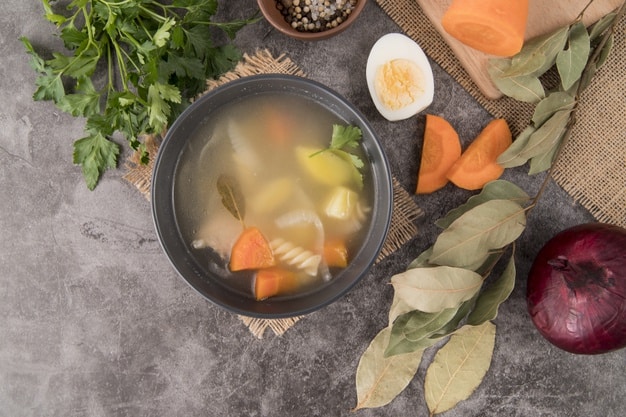Share This Article
As the fasting month approaches, there are so many things to prepare. Including a diverse and healthy vegetable menu for iftar.
After a day of thirst and hunger, the choice of iftar food is important to restore the body’s condition. The breakfasting menu chosen cannot be arbitrary. To stay healthy, try to break the fast with the ideal food.
By following the guidelines for eating vegetables during iftar , you can keep your body balanced.
In addition to maintaining your weight, you will also avoid elevated blood sugar levels and high cholesterol in your body.
Here are tips and recommendations for vegetable menus for iftar that you can try later. Let’s check out the information!
What foods are good to eat when breaking the fast?
Iftar is a good time to replenish energy levels. But what you need to know is that there are some foods that are good to consume when breaking the fast, here is the list.
1. Fruits and vegetables
When breaking the fast, dates are usually consumed at the beginning of the fast. Dates can be a good source of energy.
But in addition, dates are also rich in potassium, which can help maintain proper muscle and nerve function. As quoted from HealthXchange.sg.
You need to know that eating fruits that are rich in potassium content is important. This is because potassium is needed for the proper functioning of the body’s systems. For example, maintaining fluid and electrolyte balance in the body.
Apart from dates, other foods that also contain potassium include beans, dark leafy vegetables, potatoes, pumpkin, avocados, and bananas.
It is also important to consume vegetables that can help hydrate the body, such as lettuce, cucumber, or other vegetables that are rich in fiber and water content. Not only can these vegetables help keep your body hydrated, they can also help prevent constipation.
2. Rice and its alternatives
Whole grain bread and rice are complex carbohydrates that provide energy, fiber, and minerals to the body. They can also provide more stable and long-lasting energy levels.
3. Meat and alternatives
Eating protein foods is also a good choice when breaking the fast, such as lean meat, chicken, fish, eggs, nuts, or low-fat dairy products.
Are there any foods that should be avoided?
In addition to foods that are good to consume when breaking the fast, there are some foods that should be avoided when breaking the fast, including:
1. Foods high in sugar content
The first foods to avoid are those with a high sugar content. This is because foods high in sugar content can cause health problems if consumed in excess or too often.
2. Fried food
It’s best to limit your consumption of fried foods when breaking your fast. This is because these foods contain fat and are stored in the body as fatty tissue.
Immediately consuming foods with a high fat content at iftar after you’ve fasted for hours can also lead to acidity and indigestion.
Also, when breaking your fast, avoid consuming carbonated, soda, or processed drinks. This is because these drinks are usually high in sugar content which can cause bloating or gas.
It would be better if you consume water during iftar to quench your thirst.
Healthy tips for breaking the fast with a vegetable menu
The World Health Organization (WHO) recommends breaking the fast the traditional way. The first step to breaking the fast is to consume a glass of water and dates. Then consume vegetables and grains to re-energize the body.
Avoid fried foods and processed foods that are high in fat. Instead of using frying techniques, WHO recommends that you grill your food.
Consumption of carbohydrates such as brown rice and oats is also highly recommended.
As we already know that as an option for the protein menu, you can use fat-free meat, chicken, or fish and skin.
Most importantly, avoid overeating when breaking the fast. Instead of being full, your stomach can actually hurt if you overeat.
Inspiring vegetable menu options for iftar
Although there are many restrictions in choosing an iftar menu, you don’t need to rack your brains. Below are some inspiring vegetable menus for iftar that you can serve at home to your family:
1. Meat and vegetable soup

Making soup filled with meat broth can be a healthy vegetable menu option for iftar. Use fresh chicken or beef pieces as ingredients for broth and soup toppings.
You can also use cabbage, carrots, beans, mushrooms or other vegetables for the soup filling according to your taste.
Avoid using processed meat products such as sausages or meatballs in large quantities. You should also reduce the salt content in the soup.
As an important note, it is not recommended to make powder-based instant soup for iftar. It’s better to make it yourself.
2. Kalebelacan shrimp
Besides being easy to process, kale contains various vitamins and minerals for the body. Such as iron, protein, vitamins C and A, as well as fat and calcium. Kale has a high fluid content that can replace body fluids lost during fasting.
For those of you who don’t have allergies, you can add shrimp as a Toppings. But if you have allergies, it’s best to avoid shrimp and use protein from other food sources instead. This menu is very famous throughout Southeast Asia!
3. Green salad
Breaking your fast with a vegetable salad may not be something you do often, but you can start now. Choose green vegetables such as lettuce, zucchini and so on.
Add bell peppers, tomatoes and sauce as salad dressing . You can use sesame sauce, thousand island, or olive oil.
Green vegetables contain many vitamins and are not difficult for the body to digest. This vegetable menu for breaking the fast is also very easy to serve. Eating vegetables when breaking your fast can help you avoid indigestion.
4. Clear spinach, a vegetable option for iftar
After a long day of fasting, enjoying vegetables for iftar such as clear spinach can restore energy in your body. Spinach is rich in vitamins A, B, C and K as well as various other minerals that are good for the body.
In addition, spinach is able to stabilize blood sugar and maintain blood pressure. This is definitely a good choice for your Iftar menu.
Additionally, you can also use tomatoes and corn in the spinach clear vegetable.
5. Beef tomato soup
Another alternative vegetable menu for iftar that you can serve is beef tomato soup. At menu In this menu, beef can be served in the form of cubes or meat balls. Choose according to your taste.
Tomatoes are one of the vegetables that contain a lot of water, making it suitable as an iftar menu. In addition, tomatoes are also rich in vitamins A and C and beta carotene, which are good for your health. Well, this menu is best served while warm.
Healthy tips for fasting in Ramadan
Fasting has many benefits for the body. To keep your body healthy and fit, there are some tips that you should know when fasting in Ramadan, including:
1. Don’t skip suhoor
Lack of appetite in the morning can cause you to easily skip sahur. Though it is very important for you not to skip sahur. This is because the food you eat at suhoor will affect your energy throughout the day.
Many people often consume simple carbohydrates at suhoor. However, simple carbohydrates will not provide energy in the long run.
Instead, you can eat whole grains combined with healthy fats and proteins. Also, don’t forget to eat fruits and vegetables at suhoor.
2. Make sure your body is well hydrated
Drinking enough water has many health benefits.
It’s important to know that poor fluid intake can affect your mood or cause you to feel tired. This can affect energy levels and memory. As quoted from Healthline.
In addition, maintaining fluid or water intake in the body can also help prevent certain conditions, such as headaches, migraines, constipation, and keep blood pressure stable.
To keep your body hydrated during the fasting month, you can use the sahur and iftar times as an opportunity to fulfill your fluid intake.
Not only that, you can also eat foods with high water content, such as strawberries, watermelon, cantaloupe, cucumber, and tomatoes.
3. Don’t overeat when breaking the fast
As we’ve already explained, consuming food in excess is not good for the body. Breaking the fast should involve a balanced, nutritious meal rather than overeating.
Overeating or consuming too many high-fat foods can lead to indigestion and weight gain. Instead, make sure to eat slowly.
4. Limit or avoid fatty foods and foods with high salt content.
Fried, greasy, or high-sugar foods can make you feel better in the moment. However, these foods can make it difficult for you to fast the next day.
Besides affecting your weight, eating fatty and sugary foods can also cause you to feel sluggish or tired. It’s also important to limit your salt intake, especially during sahur. This is because it can increase thirst.
Instead, try to eat fruits and vegetables, rice and alternatives, or meat and alternatives. Eating foods with fiber content can also help.
Because fiber is digested more slowly than processed foods, it can make you feel fuller for longer.
Those are some fasting tips and menu choices that you can try and enjoy at home to keep your body healthy during fasting. If you have further questions about other healthy fasting tips, don’t hesitate to consult with your doctor.
Keep you and your family healthy with regular consultations with our partner doctors. Download the Good Doctor app now, click this link!


